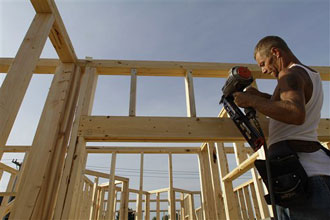U.S. Homebuilder Sentiment Improves in Nov.
U.S. homebuilders battered by the worst summer for home sales in a decade are already looking ahead to spring, saying they feel somewhat more optimistic about the prospect for an uptick in sales.
The National Association of Home Builders said Tuesday its monthly index of builders’ sentiment edged up in November to 16, the highest reading since June.
The index sank to 13 in August and September, the lowest level since March 2009. It rose to a revised reading of 15 last month, but continues to reflect an overall grim industry outlook.
Readings below 50 indicate negative sentiment about the market. The last time the index was above 50 was in April 2006. The latest report reflects a survey of 420 residential developers nationwide.
Sales of new homes hit the lowest level in more than a decade this summer after federal homebuyer tax credits expired in April. Without the government incentives — and despite mortgage rates remaining at near-historic lows — many homebuyers are opting to stay on the sidelines, put off by high unemployment, tight credit and uncertainty about home prices.
Many builders are not seeing a dramatic improvement in the number of potential buyers visiting their model homes, but those who do drop by appear to be more serious about buying in the near future, said Bob Jones, the NAHB’s chairman.
“Though the gains have been incremental, the fact that builder confidence has improved over the past two months is encouraging,” he said.
Home sales tend to slow in the fall months and into the holiday season, so builders are already setting their sights on spring, traditionally the peak season for home sales.
The index measuring current sales conditions was unchanged this month from October at 16, while the reading for foot traffic from prospective buyers rose one point to 12. But the index for sales expectations over the next six months inched up two points to 25 after improving from September to October by five points.
“This is the highest that component of the (index) has been since the homebuyer tax credit program spurred sales activity this spring,” said David Crowe, the trade association’s chief economist.
Absent another round of incentives from Uncle Sam — something no one sees happening at this point — the strength of sales next spring will hinge less on affordability and interest rates than on the course of the U.S. economy and prospects for job growth.
Still, not all builders are optimistic at this point that sales will mount a meaningful recovery early next year.
Last week, D.R. Horton Inc., one of the nation’s biggest homebuilders, said it didn’t anticipate a significant bump in sales next spring.
The Fort Worth, Texas-based builder reported its new home orders tumbled 21 percent in the July-September quarter. Other large homebuilders have recently reported sharp annual drops in orders in the same period.
Weak sales mean fewer jobs in the construction industry, which normally helps power economic recoveries. Each new home built creates, on average, the equivalent of three jobs for a year and generates about $90,000 in taxes, according to the builders’ trade group.
ALEX VEIGA, AP Real Estate Writer LOS ANGELES

Construction worker Randy Shreves begins building a new residential home in Springfield, Ill. (AP Photo/Seth Perlman)

